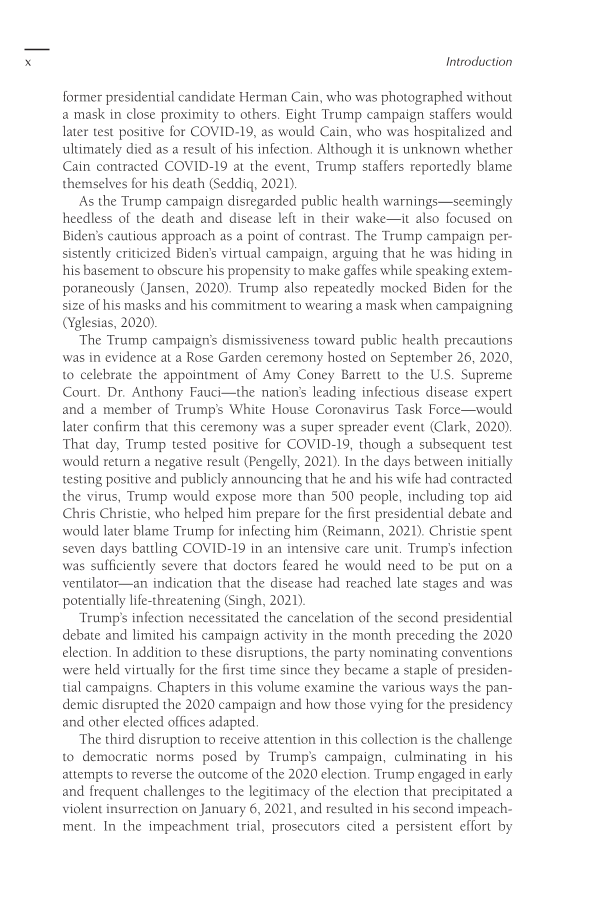x Introduction former presidential candidate Herman Cain, who was photographed without a mask in close proximity to others. Eight Trump campaign staffers would later test positive for COVID-19, as would Cain, who was hospitalized and ultimately died as a result of his infection. Although it is unknown whether Cain contracted COVID-19 at the event, Trump staffers reportedly blame themselves for his death (Seddiq, 2021). As the Trump campaign disregarded public health warnings—seemingly heedless of the death and disease left in their wake—it also focused on Biden’s cautious approach as a point of contrast. The Trump campaign per- sistently criticized Biden’s virtual campaign, arguing that he was hiding in his basement to obscure his propensity to make gaffes while speaking extem- poraneously (Jansen, 2020). Trump also repeatedly mocked Biden for the size of his masks and his commitment to wearing a mask when campaigning (Yglesias, 2020). The Trump campaign’s dismissiveness toward public health precautions was in evidence at a Rose Garden ceremony hosted on September 26, 2020, to celebrate the appointment of Amy Coney Barrett to the U.S. Supreme Court. Dr. Anthony Fauci—the nation’s leading infectious disease expert and a member of Trump’s White House Coronavirus Task Force—would later confirm that this ceremony was a super spreader event (Clark, 2020). That day, Trump tested positive for COVID-19, though a subsequent test would return a negative result (Pengelly, 2021). In the days between initially testing positive and publicly announcing that he and his wife had contracted the virus, Trump would expose more than 500 people, including top aid Chris Christie, who helped him prepare for the first presidential debate and would later blame Trump for infecting him (Reimann, 2021). Christie spent seven days battling COVID-19 in an intensive care unit. Trump’s infection was sufficiently severe that doctors feared he would need to be put on a ventilator—an indication that the disease had reached late stages and was potentially life-threatening (Singh, 2021). Trump’s infection necessitated the cancelation of the second presidential debate and limited his campaign activity in the month preceding the 2020 election. In addition to these disruptions, the party nominating conventions were held virtually for the first time since they became a staple of presiden- tial campaigns. Chapters in this volume examine the various ways the pan- demic disrupted the 2020 campaign and how those vying for the presidency and other elected offices adapted. The third disruption to receive attention in this collection is the challenge to democratic norms posed by Trump’s campaign, culminating in his attempts to reverse the outcome of the 2020 election. Trump engaged in early and frequent challenges to the legitimacy of the election that precipitated a violent insurrection on January 6, 2021, and resulted in his second impeach- ment. In the impeachment trial, prosecutors cited a persistent effort by
Document Details My Account Print multiple pages
Print
You have printed 0 times in the last 24 hours.
Your print count will reset on at .
You may print 0 more time(s) before then.
You may print a maximum of 0 pages at a time.



























































































































































































































































































































































